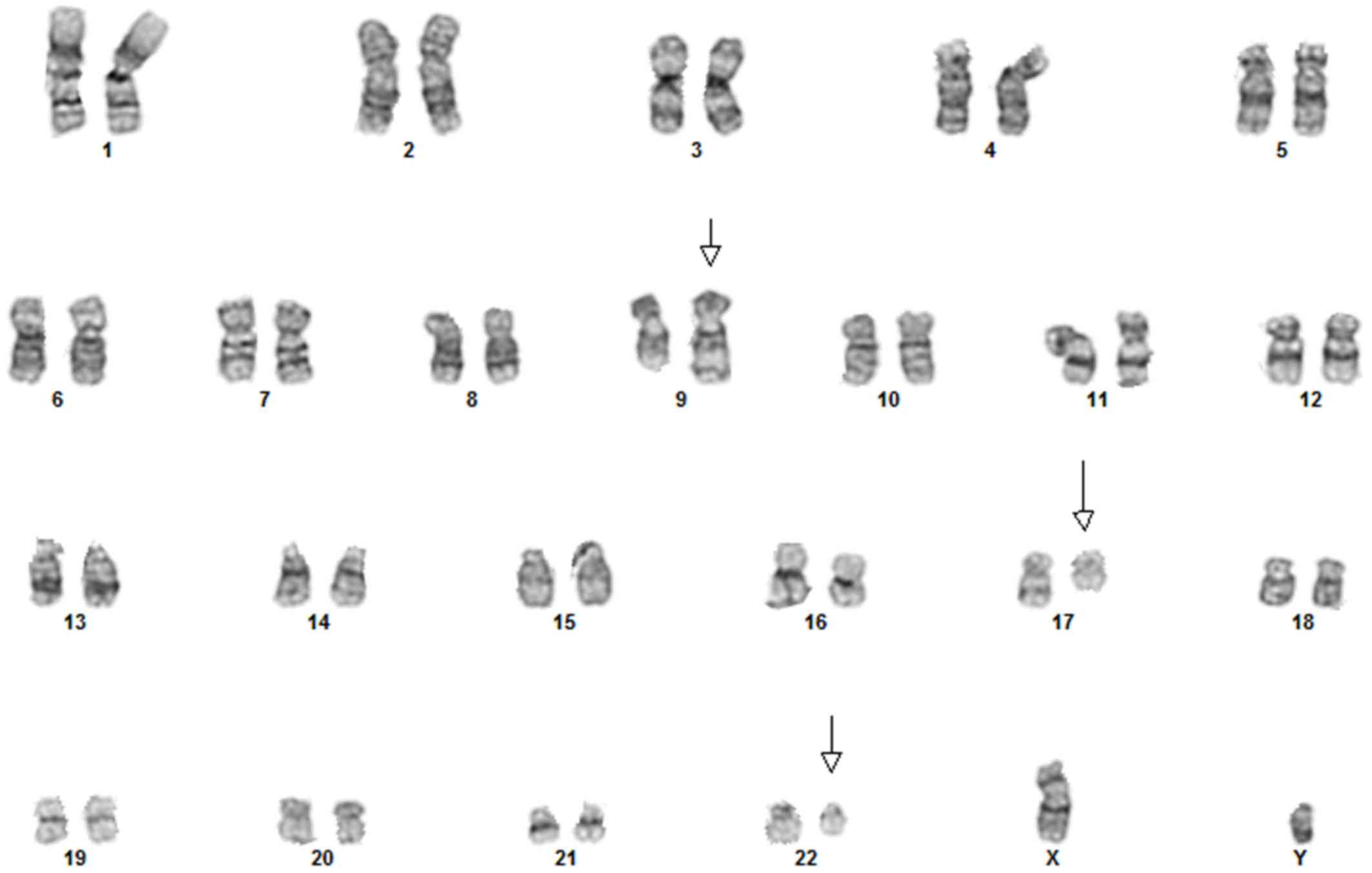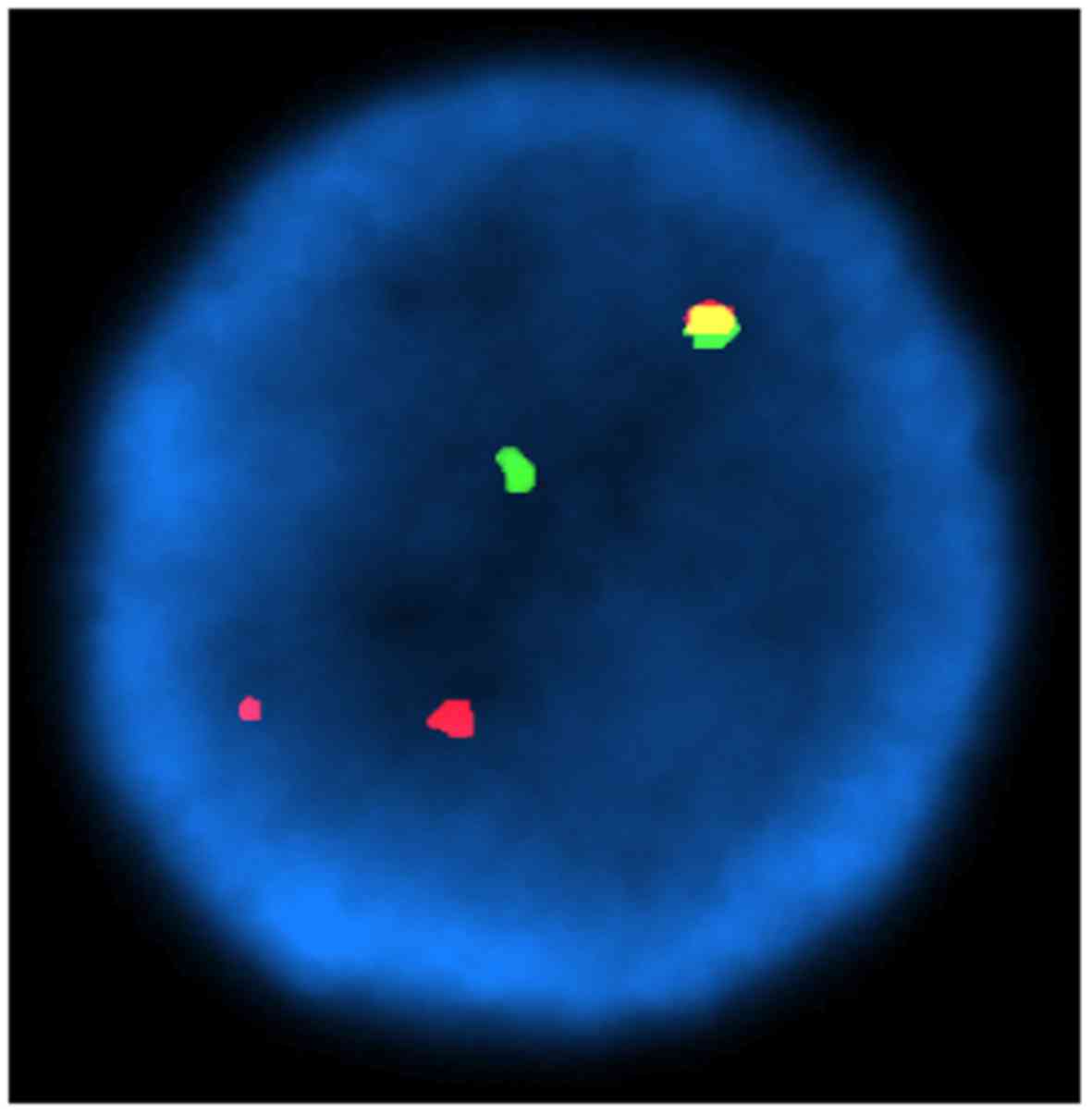Introduction
Chronic myeloid leukemia (CML) is a hematologic
malignancy associated with increased circulating myeloid cells and
platelets in the peripheral blood, with accompanying bone marrow
hyperplasia. The Philadelphia chromosome, t(9;22)(q34;q11), is
present in 95% of CML patients, and is the result of a balanced
translocation between the long arms of chromosome 9, harboring the
Abl protooncogene, and chromosome 22, harboring the Bcr
protooncogene (1,2). The resulting chimeric Bcr-Abl gene
leads to constitutive tyrosine kinase activity. Approximately 5% of
CML patients possess a variant of the Philadelphia chromosome
(2). Here we describe a patient with
chronic phase CML who presented with a novel three-way
(9;22;17)(q34;q11.2;q11.2) Philadelphia chromosome
translocation.
Case report
In January of 2017, a 54 year old man was
transferred to our institution from an outside facility with
leukocytosis, anemia, and thrombocytosis. His hematologic
parameters were as follows: White blood cells 84.2 K/ul, red blood
cells 3.96 M/ul, hemoglobin 10.5 g/dl, hematocrit 32.1%, red cell
distribution width 19.0%, and platelets 641 K/ul. A peripheral
blood film showed increased polychromasia and increased
anisocytosis and poikilocytosis, with acanthocytes, schistocytes,
dacryocytes, and elliptocytes identified. There was a left shift in
the peripheral granulocyte population, with a manual differential
count finding 1% blasts, 1% promyelocytes, 11% myelocytes, 8%
metamyelocytes, 10% neutrophil bands, 45% segmented neutrophils, 3%
eosinophils, 4% basophils, 8% lymphocytes, and 9% monocytes.
The bone marrow aspirate showed hypercellular
particles and a left shift in the myelocyte peak, with 5% erythroid
precursors, 2% myeloid blasts, 7% promyelocytes, 42% myelocytes,
23% metamyelocytes and bands, 18% neutrophils, and 3%
eosinophils.
On flow cytometry analysis of the bone marrow, 84%
of cells fell within the granulocyte gate, 8% in the nucleated red
blood cell gate, and 2% each in the lymphocyte gate, CD45 dim gate,
and monocyte gate. The gated population of CD45 dim cells showed
partial expression of early markers CD117 and CD34, consistent with
myeloid blasts (0.4% of total cell population).
Cytogenetic analysis was performed on bone marrow
cells collected at the time of primary diagnosis and cultured using
standard techniques. From this, twenty GTG banded metaphase cells
were analyzed and all were found to possess a complex, three-way
(9;22;17)(q34.1;q11.2;q11.2) Philadelphia chromosome translocation
(Fig. 1). Further analysis by
fluorescence in situ hybridization (FISH) utilizing
dual-color fusion probes confirmed the presence of Bcr-Abl
translocation in 86 out of 100 interphase cells (Fig. 2).
Discussion
The Philadelphia chromosome t(9;22)(q34;q11) is
present in greater than 90% of CML patients, however approximately
5% of patients demonstrate variants in which a third chromosome in
addition to chromosomes 9 and 22 is also involved (1). These complex three-way translocations
could be formed by two mechanisms. Either there could be a one-step
translocation involving three chromosomes at the same time, or a
two-step mechanism where first a typical t(9;22) translocation
occurs, followed by a second translocation between the aberrant
chromosome 9 or 22 and the 3rd chromosome (2). The most frequently involved chromosomes
in variant Philadelphia translocation are 3p21, 3q21, 11q13, 12p13,
and 17q25 (3). Other chromosomes
that have been rarely involved in variant Philadelphia
translocation include 4q25 (4),
10p11.2 (5), 11p15 (6), 17p11.2 (7), and 21p12 (8). One uniting factor, however, is that all
of these variants ultimately lead to a Bcr-Abl fusion gene
(3,9). The exact translocation present in our
patient has not been previously reported, however analysis by FISH
confirmed the presence of a Bcr-Able fusion gene.
The clinical presentation of CML patients with
variant Philadelphia chromosomes is indistinguishable from that of
patients with the classic translocation. Additionally, several
reports have found that Philadelphia chromosome variant patients
tend to have a similar prognosis to those with the classic
Philadelphia translocation when treated with imatinib therapy
(10).
In conclusion, we report a rare case of chronic
phase CML with a novel complex three-way Philadelphia variant
t(9;22;17)(q34;q11.2,q12).
References
|
1
|
Asif M, Hussain A, Malik A and Rasool M:
Three-way complex variant translocation involving short arm
chromosome (1;9;22)(p36;q34;q11) in a chronic myeloid leukemia
patient. Oncol Lett. 10:1728–1730. 2015. View Article : Google Scholar : PubMed/NCBI
|
|
2
|
Tanaka K, Minamihisamatu M, Yagi SH, Kyo
T, Dohy H and Kamada N: Two step mechanism for formation of complex
9;22 chromosome translocation in chronic myelocytic leukemia
detected by fluorescence in situ hybridization. Exp Oncol.
23:29–38. 2001.
|
|
3
|
Dierlamm J, Michaux L, Stefanova M, Eggert
J, Leberecht P, Seeger D, Westerhausen M and Hossfeld DK: Novel
Philadelphia variant t(Y;9;22)(q12;q34;q11) in a case of chronic
myeloid leukemia. Cancer Genet Cytogenet. 114:150–153. 1999.
View Article : Google Scholar : PubMed/NCBI
|
|
4
|
Sheth FJ, Sheth JJ and Verhest A: A three
way complex translocation (4; 9; 22) in two patients with chronic
myelocytic leukemia. J Cancer Res Ther. 1:108–110. 2005. View Article : Google Scholar : PubMed/NCBI
|
|
5
|
Al-Achkar W, Wafa A, Ikhtiar A and Liehr
T: Three-way Philadelphia translocation t(9;10;22)(q34;p11.2;q11.2)
as a secondary abnormality in an imatinib mesylate-resistant
chronic myeloid leukemia patient. Oncol Lett. 5:1656–1658. 2013.
View Article : Google Scholar : PubMed/NCBI
|
|
6
|
Asif M, Hussain A and Rasool M: A rare
case of a three way complex variant positive Philadelphia
translocation involving chromosome (9;11;22)(q34;p15;q11) in
chronic myeloid leukemia: A case report. Oncol Lett. 12:1986–1988.
2016. View Article : Google Scholar : PubMed/NCBI
|
|
7
|
Kokate P, Dalvi R and Mandava S: A complex
three-way translocation with deletion of the TP53 gene in a blast
crisis chronic myeloid leukemia patient. J Cancer Res Ther.
11:10372015. View Article : Google Scholar : PubMed/NCBI
|
|
8
|
Al-Achkar W, Wafa A, Moassass F and Liehr
T: A chronic myeloid leukemia case with a unique variant
Philadelphia translocation: t(9;22;21)(q34;q11;p12). Oncol Lett.
3:1027–1029. 2012. View Article : Google Scholar : PubMed/NCBI
|
|
9
|
Mitelman F and Heim S: Cancer
Cytogenetics: Chromosomal and Molecular Genetic Aberrations of
Tumor Cells. 2nd. Wiley-Liss, Inc.; New York: 1995, View Article : Google Scholar
|
|
10
|
Valencia A, Cervera J, Such E, Barragán E,
Bolufer P, Fuster O, Collado R, Martínez J and Sanz MA: Complex
variant t(9;22) chromosome translocations in five cases of chronic
myeloid leukemia. Adv Hematol. 2009:1871252019.
|
















